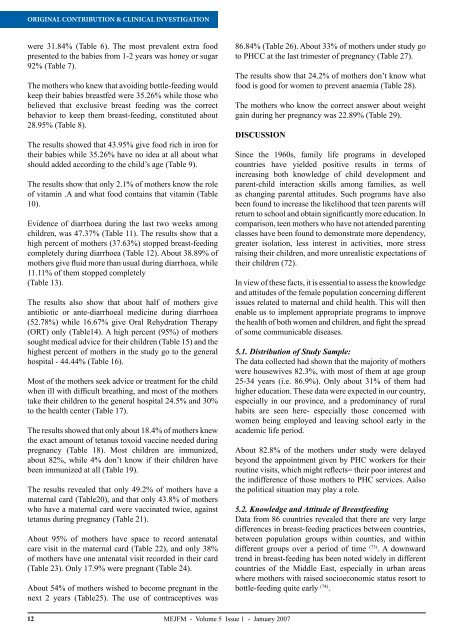Contents - Middle East Journal of Family Medicine
Contents - Middle East Journal of Family Medicine
Contents - Middle East Journal of Family Medicine
You also want an ePaper? Increase the reach of your titles
YUMPU automatically turns print PDFs into web optimized ePapers that Google loves.
ORIGINAL CONTRIBUTION & CLINICAL INVESTIGATIONwere 31.84% (Table 6). The most prevalent extra foodpresented to the babies from 1-2 years was honey or sugar92% (Table 7).The mothers who knew that avoiding bottle-feeding wouldkeep their babies breastfed were 35.26% while those whobelieved that exclusive breast feeding was the correctbehavior to keep them breast-feeding, constituted about28.95% (Table 8).The results showed that 43.95% give food rich in iron fortheir babies while 35.26% have no idea at all about whatshould added according to the child’s age (Table 9).The results show that only 2.1% <strong>of</strong> mothers know the role<strong>of</strong> vitamin .A and what food contains that vitamin (Table10).Evidence <strong>of</strong> diarrhoea during the last two weeks amongchildren, was 47.37% (Table 11). The results show that ahigh percent <strong>of</strong> mothers (37.63%) stopped breast-feedingcompletely during diarrhoea (Table 12). About 38.89% <strong>of</strong>mothers give fluid more than usual during diarrhoea, while11.11% <strong>of</strong> them stopped completely(Table 13).The results also show that about half <strong>of</strong> mothers giveantibiotic or ante-diarrhoeal medicine during diarrhoea(52.78%) while 16.67% give Oral Rehydration Therapy(ORT) only (Table14). A high percent (95%) <strong>of</strong> motherssought medical advice for their children (Table 15) and thehighest percent <strong>of</strong> mothers in the study go to the generalhospital - 44.44% (Table 16).Most <strong>of</strong> the mothers seek advice or treatment for the childwhen ill with difficult breathing, and most <strong>of</strong> the motherstake their children to the general hospital 24.5% and 30%to the health center (Table 17).The results showed that only about 18.4% <strong>of</strong> mothers knewthe exact amount <strong>of</strong> tetanus toxoid vaccine needed duringpregnancy (Table 18). Most children are immunized,about 82%, while 4% don’t know if their children havebeen immunized at all (Table 19).The results revealed that only 49.2% <strong>of</strong> mothers have amaternal card (Table20), and that only 43.8% <strong>of</strong> motherswho have a maternal card were vaccinated twice, againsttetanus during pregnancy (Table 21).About 95% <strong>of</strong> mothers have space to record antenatalcare visit in the maternal card (Table 22), and only 38%<strong>of</strong> mothers have one antenatal visit recorded in their card(Table 23). Only 17.9% were pregnant (Table 24).About 54% <strong>of</strong> mothers wished to become pregnant in thenext 2 years (Table25). The use <strong>of</strong> contraceptives was86.84% (Table 26). About 33% <strong>of</strong> mothers under study goto PHCC at the last trimester <strong>of</strong> pregnancy (Table 27).The results show that 24.2% <strong>of</strong> mothers don’t know whatfood is good for women to prevent anaemia (Table 28).The mothers who know the correct answer about weightgain during her pregnancy was 22.89% (Table 29).DISCUSSIONSince the 1960s, family life programs in developedcountries have yielded positive results in terms <strong>of</strong>increasing both knowledge <strong>of</strong> child development andparent-child interaction skills among families, as wellas changing parental attitudes. Such programs have alsobeen found to increase the likelihood that teen parents willreturn to school and obtain significantly more education. Incomparison, teen mothers who have not attended parentingclasses have been found to demonstrate more dependency,greater isolation, less interest in activities, more stressraising their children, and more unrealistic expectations <strong>of</strong>their children (72).In view <strong>of</strong> these facts, it is essential to assess the knowledgeand attitudes <strong>of</strong> the female population concerning differentissues related to maternal and child health. This will thenenable us to implement appropriate programs to improvethe health <strong>of</strong> both women and children, and fight the spread<strong>of</strong> some communicable diseases.5.1. Distribution <strong>of</strong> Study Sample:The data collected had shown that the majority <strong>of</strong> motherswere housewives 82.3%, with most <strong>of</strong> them at age group25-34 years (i.e. 86.9%). Only about 31% <strong>of</strong> them hadhigher education. These data were expected in our country,especially in our province, and a predominancy <strong>of</strong> ruralhabits are seen here- especially those concerned withwomen being employed and leaving school early in theacademic life period.About 82.8% <strong>of</strong> the mothers under study were delayedbeyond the appointment given by PHC workers for theirroutine visits, which might reflects= their poor interest andthe indifference <strong>of</strong> those mothers to PHC services. Aalsothe political situation may play a role.5.2. Knowledge and Attitude <strong>of</strong> BreastfeedingData from 86 countries revealed that there are very largedifferences in breast-feeding practices between countries,between population groups within counties, and withindifferent groups over a period <strong>of</strong> time (73) . A downwardtrend in breast-feeding has been noted widely in differentcountries <strong>of</strong> the <strong>Middle</strong> <strong>East</strong>, especially in urban areaswhere mothers with raised socioeconomic status resort tobottle-feeding quite early (74) .12MEJFM - Volume 5 Issue 1 - January 2007
















